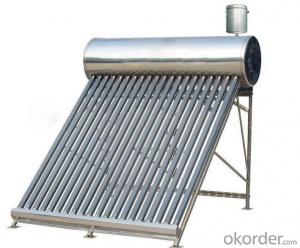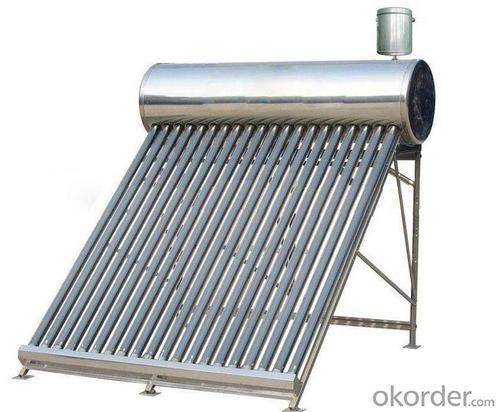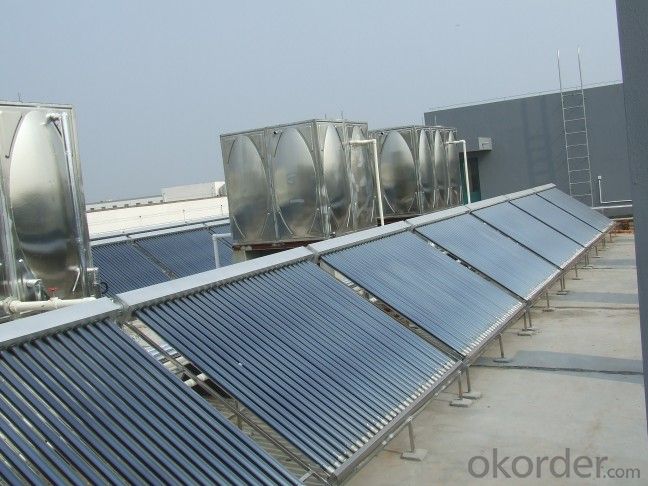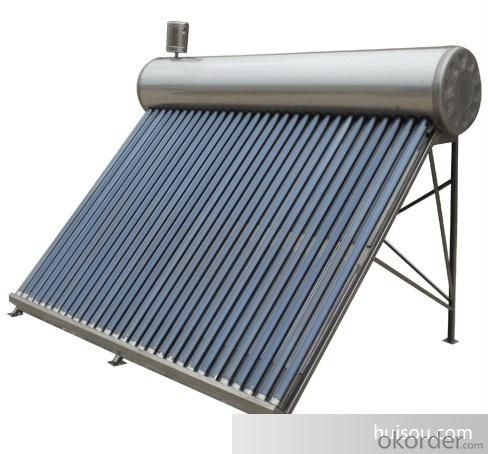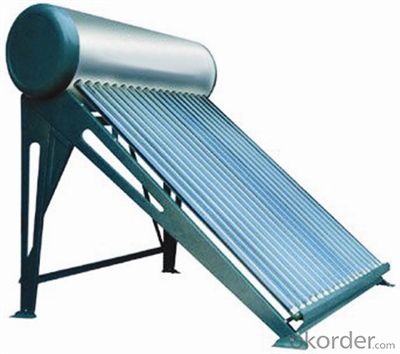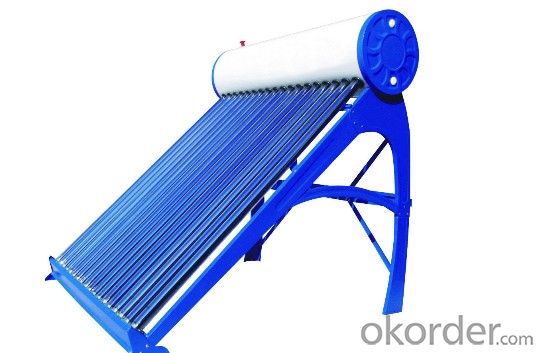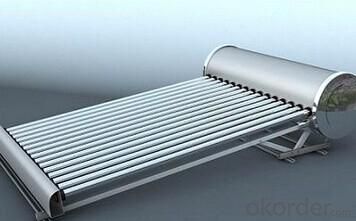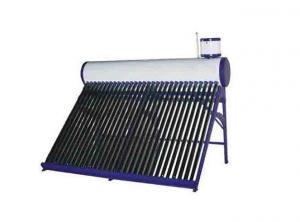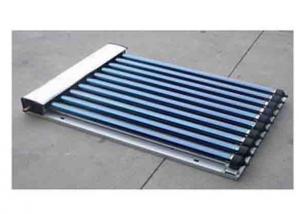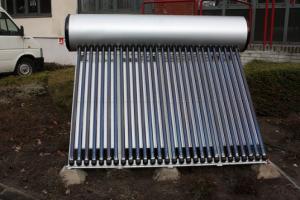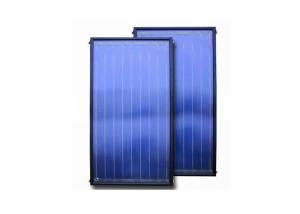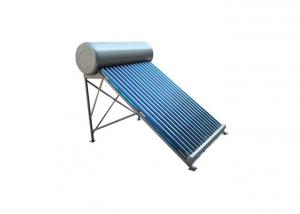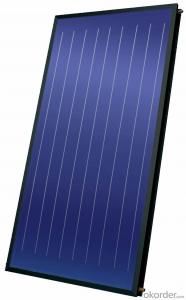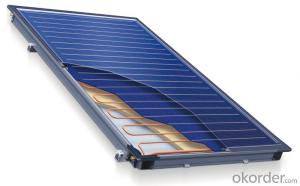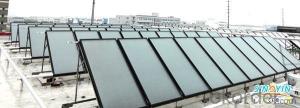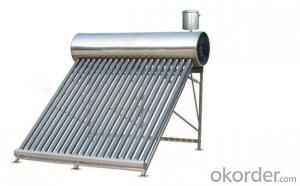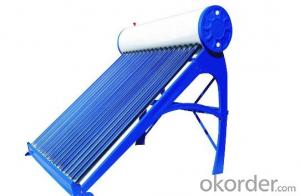Steam Solar Collectors with Copper Pressurized Heat Pipe Solar Water Heater System
- Loading Port:
- China main port
- Payment Terms:
- TT OR LC
- Min Order Qty:
- 1 set
- Supply Capability:
- 6000 set/month
OKorder Service Pledge
OKorder Financial Service
You Might Also Like
Introduction of Non-Pressure Solar Water Heater:
Non-pressure Solar Heater is one of the most economical solar water heating device with pretty high efficiency at the same time. It consists of hot water storage tank, solar vacuum tubes with mouth plug in storage tank, and bracket supporting tank and tubes.When cold water in evacuated tubes is heated with solar irradiation, as the specific gravities of hot water and cold water are different, hotter water goes upward to storage tank and colder water goes downward to glass tubes. through this continuous circulation, the cold water in storage tank will be gradually heated till sunset.
Specialty:
1. High thermal performance and working temperature: the heat exchanging rate even in winter can up above 55%.
2. Heat collecting efficiency is at least 20% above common solar systems.
3. Work in all day and all season: no matter any corner of the world, this system can work well even -40℃ to avoid the tube freezing problem.
4. Reliability: No water following through the tube, so water scale can not generate and tube cracks could be avoided, the system still can keep working even with some damaged tubes.
5. It can connect with water tap and work automatically with pressure0.6Mpa, bring enjoyable washing experience.
6. Safety: P/T valve would release pressure and temperature to protect tank..
Technical Specification:
1. Outer tank material: SUS304 stainless steel or powder coated color steel
2. Inner tank material: 1.2mm thick SUS304 food grade stainless steel ( Optional material SUS316L)
3. Vacuum tube material: borosilicate glass 3.3; AL-SS-CU absorb coating, with copper heat pipe inside
4. Frame material: 1.2mm thickness stainless steel
5. Insulation material: 55mm thickness polyurethane
6. Suitable for mains pressure water(up to 8 bar/116psi)
7. Easy plug-in installation
8. Install the T/P valve on the pressurized tank
9. Seal material: Stabilized High Temperature Silicon
Outer tank material: SUS304 stainless steel or powder coated color steel
Inner tank material: 1.2mm thick SUS304 food grade stainless steel ( Optional material SUS316L)
Vacuum tube material: borosilicate glass 3.3; AL-SS-CU absorb coating, with copper heat pipe inside
Frame material: 1.2mm thickness stainless steel
Insulation material: 55mm thickness polyurethane
Suitable for mains pressure water(up to 8 bar/116psi)
Easy plug-in installation
Install the T/P valve on the pressurized tank
Seal material: Stabilized High Temperature Silicon
19. Vacuum Tube | 20. Size (mm) | 21. Φ47*1500 / Φ58*1800 / Φ70*2100 | |||||
22. Tube (pcs) | 23. 10 / 12 / 15 / 18 / 20 / 22 / 24 / 30 / 36 / 42 | ||||||
24. Material | 25. Borosilicate 3.3 glass, magnetron spluttering selective coating | ||||||
26. Coating | 27. Single-target AL-N/AL or Three-target AL/N-Cu-SS | ||||||
28. Water Tank | 29. Capacity | 30. 80L ~ 500L for hot water storage tank | |||||
31. Inner tank | 32. Food-grade stainless steel SUS304-2B / SUS316 | ||||||
33. Insulation | 34. High-density polyurethane foam with 70~80 hour heat preservation | ||||||
35. Tank shell | 36. Food-grade stainless steel SUS304-2B | ||||||
37. Bracket | 38. Shaped strong aluminum alloy structure adaptable for flat or slope roof | ||||||
39. Accessories | 40. Anti-aging silicon seals, Dustproof seals, Air-vent cap, Stainless screws | ||||||
41. Auxiliary Devices | 42. Assistant tank, Intelligent controller, Electrical heater, Magnesium anodes | ||||||
43. Tilt Angle | 44. 25 ~ 50° | ||||||
45. Water Output | 46. 45 - 95°C | ||||||
47. Hail Resistance | 48. Φ25mm diameter | ||||||
49. Model Number | 50. Solar Vacuum Tube | 51. Tank 52. Liter | 53. System 54. Liter | 55. Container Loading Qty /sets | |||
56. Size /mm | 57. Qty /pcs | 58. 20GP | 59. 40GP | 60. 40HQ | |||
61. VNS-58SA12-100 | 62. Φ58*1800 | 63. 12 | 64. 100 | 65. 132 | 66. 58 | 67. 119 | 68. 140 |
69. VNS-58SA15-130 | 70. 15 | 71. 130 | 72. 170 | 73. 54 | 74. 108 | 75. 131 | |
76. VNS-58SA18-150 | 77. 18 | 78. 150 | 79. 198 | 80. 43 | 81. 86 | 82. 105 | |
83. VNS-58SA20-170 | 84. 20 | 85. 170 | 86. 223 | 87. 40 | 88. 80 | 89. 97 | |
VNS-58SA24-200 | 24 | 200 | 263 | 35 | 70 | 85 | |
VNS-58SA30-250 | 30 | 250 | 329 | 28 | 56 | 68 | |
VNS-58SA36-300 | 36 | 300 | 395 | 23 | 47 | 57 | |
Product Show
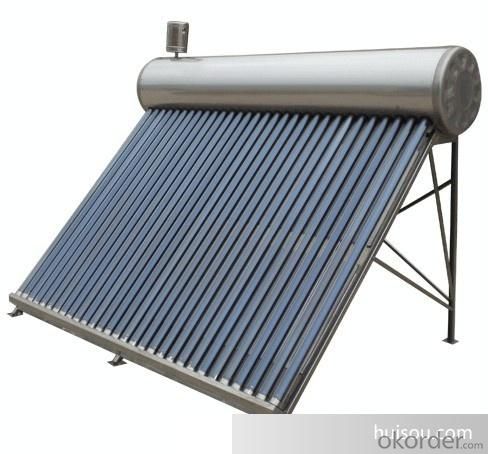
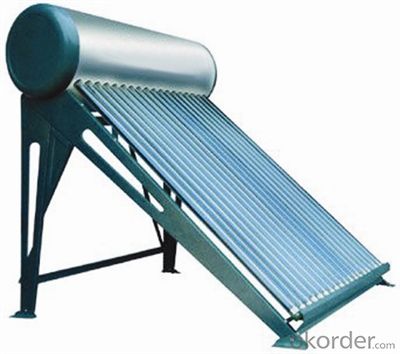
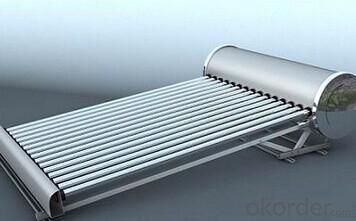
Our Services
1. OEM service
2. Warranty: 5 years
3. Considerable after sale service
Color steel Compact pressure Thermal solar heater
FAQ:
1. What’s the delivery time?
10 days after receiving deposit.
2. How long is the warranty?
5 years for whole system, 1 year for accessory
3. What’s your production capacity?
6000sets/month
4. What’s the MOQ?
1 set.
5. What’s your payment term?
Container: 30% T/T in advance for deposit, 70% T/T before shipment for fist order.
70% T/T after seeing copy of B/L from second order
Sample: 100% T/T in advance
Other choices: L/C at sight.
6. What certifications do you have?
CE, SOLAR KEYMARK, SRCC and etc.
- Q: What is the weight of a solar collector?
- The weight of a solar collector can vary depending on its size, design, and materials used. On average, a typical residential solar collector can weigh anywhere between 100 to 300 pounds. However, larger commercial or industrial solar collectors can weigh several thousand pounds.
- Q: Are there any noise or pollution concerns associated with solar collectors?
- No, solar collectors do not produce any noise or pollution. They generate electricity by harnessing the sun's energy, resulting in a clean and silent operation.
- Q: How much space is required for installing a solar collector?
- The space required for installing a solar collector depends on the size and type of the collector. Generally, a typical solar collector for residential use can take up around 10-15 square feet of roof space. However, larger solar collectors or installations for commercial or industrial purposes may require significantly more space. It is important to consult with a solar professional to determine the specific space requirements for your desired solar collector installation.
- Q: Can solar collectors be used for heating tourist attractions and theme parks?
- Yes, solar collectors can be used for heating tourist attractions and theme parks. Solar thermal systems can capture energy from the sun and convert it into heat, which can then be used for various purposes, including heating water for pools, providing space heating, or even powering attractions that require heat. This sustainable and renewable energy source can help reduce reliance on fossil fuels, lower operating costs, and contribute to a greener and more environmentally friendly tourist experience.
- Q: Can solar collectors be used in biomass power plants?
- Solar collectors can indeed be employed in biomass power plants, which can ultimately improve the facility's efficiency and sustainability. By integrating solar collectors into biomass power plants, the overall effectiveness and environmental impact of the facility can be enhanced. Utilizing solar collectors enables the provision of supplementary heat to the biomass combustion process, thereby elevating energy output and decreasing dependence on fossil fuels. This integration allows for a consistent and dependable energy supply, as solar energy can be tapped into even during fluctuations in biomass fuel availability. Moreover, employing solar collectors in biomass power plants aids in reducing greenhouse gas emissions and mitigating the facility's environmental consequences. Ultimately, the combination of solar collectors and biomass power plants creates a more efficient and sustainable energy generation system.
- Q: Can solar collectors be used for generating electricity on stadiums?
- Absolutely, solar collectors are a viable option for generating electricity in stadiums. In fact, stadiums all over the world are already embracing solar energy to produce electricity and lessen their environmental impact. Solar collectors, also known as solar panels or photovoltaic (PV) panels, convert sunlight into electricity using the photovoltaic effect. Stadiums, being large structures with expansive rooftops and open spaces, are ideal locations for installing solar collectors. These panels can be mounted on the rooftops, canopies, or specially designed structures around the stadium. By harnessing the ample sunlight that falls on these surfaces, stadiums can generate clean and renewable electricity. The electricity generated by solar collectors in stadiums can power various elements such as lighting systems, scoreboards, sound systems, and other electrical equipment. Moreover, any excess electricity generated can be fed back into the grid, offsetting the stadium's energy consumption and potentially bringing in revenue through feed-in tariffs or net metering programs. Aside from the obvious environmental benefits, utilizing solar collectors in stadiums can also bring economic advantages. By generating their own electricity, stadiums can decrease their reliance on fossil fuels, reduce energy costs, and save substantial amounts of money in the long term. Additionally, stadiums can take advantage of government incentives and tax breaks that encourage the adoption of renewable energy sources. In conclusion, solar collectors can indeed be used to generate electricity in stadiums. Their installation can help stadiums become more sustainable, reduce their carbon footprint, save on energy costs, and contribute to the overall transition towards clean and renewable energy sources.
- Q: How long does it take for a solar collector to reach optimal temperature?
- The time it takes for a solar collector to reach optimal temperature can vary depending on factors such as the size and type of collector, the amount of sunlight available, and the temperature of the surroundings. Generally, it can take anywhere from 30 minutes to a couple of hours for a solar collector to reach its optimal temperature.
- Q: Can solar collectors be used for heating chapels?
- Yes, solar collectors can be used for heating chapels. By harnessing the power of the sun, solar collectors can generate heat that can be used to warm up the interior of a chapel, providing a renewable and sustainable heating solution.
- Q: Can solar collectors be used in climate change mitigation efforts?
- Yes, solar collectors can be used in climate change mitigation efforts. They are a sustainable and renewable energy source that can reduce greenhouse gas emissions by replacing fossil fuel energy generation. Solar collectors convert sunlight into electricity or heat, providing clean energy that can be used for various purposes such as powering homes, businesses, and industries. By relying more on solar energy, we can reduce our dependence on fossil fuels, decrease carbon emissions, and contribute to mitigating the impacts of climate change.
- Q: Can solar collectors be used for heating orphanages?
- Indeed, orphanages can utilize solar collectors for heating purposes. These solar thermal systems are specifically designed to capture and utilize the sun's energy to generate heat. By making use of this sustainable energy source, orphanages can significantly decrease their dependence on traditional heating systems, resulting in lower energy costs and reduced carbon emissions. Solar collectors function by absorbing sunlight and converting it into usable thermal energy. This energy can then be employed to heat water, which can be circulated through radiators or underfloor heating systems, ensuring warmth within the orphanage. Solar thermal systems are particularly effective in sunny regions, where they can provide a consistent and dependable heat source all year round. The implementation of solar collectors in orphanages brings numerous advantages. Firstly, it aids in cost reduction by decreasing electricity or fuel expenses. This financial relief enables orphanages to allocate funds to other important needs. Furthermore, solar collectors present an environmentally friendly solution as they operate without emitting greenhouse gases. By adopting solar heating, orphanages can contribute to a cleaner environment and set a positive example for the children in their care. However, certain factors must be considered when incorporating solar collectors for orphanage heating. The size and capacity of the system must be carefully evaluated to ensure it meets the facility's heating requirements. Adequate space for installing the solar collectors should also be available, preferably in a location with optimal sun exposure. Additionally, regular maintenance and inspections are essential to ensure the long-term efficiency and performance of the system. In conclusion, solar collectors are an excellent choice for heating orphanages. They provide a renewable and cost-effective solution that greatly benefits these facilities, both financially and environmentally. By harnessing the power of the sun, orphanages can create a warm and comfortable environment for the children they care for, while promoting sustainability and reducing their carbon footprint.
Send your message to us
Steam Solar Collectors with Copper Pressurized Heat Pipe Solar Water Heater System
- Loading Port:
- China main port
- Payment Terms:
- TT OR LC
- Min Order Qty:
- 1 set
- Supply Capability:
- 6000 set/month
OKorder Service Pledge
OKorder Financial Service
Similar products
Hot products
Hot Searches
Related keywords
